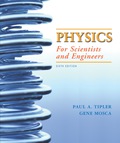
Concept explainers
(a)
To Calculate:The orbital period of the space craft.
(a)
Answer to Problem 57P
Explanation of Solution
Given data:
Mass of the spacecraft,
Formula Used:
From Kepler’s third law, the square of the period
Here,
Calculation:
The height of the spacecraft is
Here,
Substitute
From Kepler’s third law, the square of the period
Here,
Substitute
Thus, the expression for the period of the spacecraft’s orbit about the Earth is,
Substitute the values and solve:
Conclusion:
The orbital period of te space craft is
(b)
The kinetic energy of the spacecraft
(b)
Answer to Problem 57P
Explanation of Solution
Given data:
Mass of the spacecraft,
Formula used:
The kinetic energy of the spacecraft is
Here,
The orbital velocity of the spacecraft is expressed as follows:
Calculation:
Substitute
Substitute the values:
Conclusion:
The kinetic energy of the spacecraft is
(c)
The
(c)
Answer to Problem 57P
Explanation of Solution
Given data:
Mass of the spacecraft,
Formula used:
The moment of inertia of the space craft is
Calculation:
Substitute the values and solve:
The angular momentum of the spacecraft in terms of kinetic energy is
Substitute the values:
Conclusion:
The angular momentum of the spacecraft is
Want to see more full solutions like this?
Chapter 11 Solutions
Physics for Scientists and Engineers
- Check Your Understanding By what factor must the radius change to reduce the orbital velocity of a satellite by one-half? By what factor would this change the period?arrow_forwardSuppose the polar ice sheets broke free and floated toward Earth’s equator without melting. What would happen to Earth’s angular velocity?arrow_forwardWhat is the orbital radius of an Earth satellite having a period of 1.00 h? (b) What is unreasonable about this result?arrow_forward
- Check Your Understanding Assume you are in a spacecraft in orbit about the Sun at Earth’s orbit, but far away from Earth (so that it can be ignored). How could you redirect your tangential velocity to the radial direction such that you could then pass by Mars’s orbit? What would be required to change just the direction of the velocity?arrow_forwardThe Sun’s mass is 2.01030kg , its radius is 7.0105km , and it has a rotational period of approximately 28 days. If the Sun should collapse into a white dwarf of radius 3.5103km , what would its period be if no mass were ejected and a sphere of uniform density can model the Sun both before and after?arrow_forwardGiven the perihelion distance, p , and aphelion distance, q , for an elliptical orbit, show that the velocity at perihelion, vp , is given by vp=2GMSun(q+p)qp . (Hint: Use conservation of angular momentum to relate vp and vq , and then substitute into the conservation fo energy equation.)arrow_forward
- A projectile is shot directly away from Earth's surface. Neglect the rotation of the Earth. What multiple of Earth's radius RE gives the radial distance (from the Earth's center) the projectile reaches if (a) its initial speed is 0.478 of the escape speed from Earth and (b) its initial kinetic energy is 0.478 of the kinetic energy required to escape Earth? (Give your answers as unitless numbers.) (c) What is the least initial mechanical energy required at launch if the projectile is to escape Earth? (a) Number i (b) Number i (c) Number i Units Units Units î î ✪arrow_forwardA projectile is shot directly away from Earth's surface. Neglect the rotation of the Earth. What multiple of Earth's radius Re gives the radial distance (from the Earth's center) the projectile reaches if (a) its initial speed is 0.507 of the escape speed from Earth and (b) its initial kinetic energy is 0.507 of the kinetic energy required to escape Earth? (Give your answers as unitless numbers.) (c) What is the least initial mechanical energy required at launch if the projectile is to escape Earth? (a) Number (b) Number (c) Number Units Units Units This answer has no units This answer has no unitsarrow_forwardA projectile is shot directly away from Earth's surface. Neglect the rotation of the Earth. What multiple of Earth's radius RE gives the radial distance (from the Earth's center) the projectile reaches if (a) its initial speed is 0.566 of the escape speed from Earth and (b) its initial kinetic energy is 0.566 of the kinetic energy required to escape Earth? (Give your answers as unitless numbers.) (c) What is the least initial mechanical energy required at launch if the projectile is to escape Earth?arrow_forward
- A projectile is shot directly away from Earth's surface. Neglect the rotation of the Earth. What multiple of Earth's radius RE gives the radial distance (from the Earth's center) the projectile reaches if (a) its initial speed is 0.562 of the escape speed from Earth and (b) its initial kinetic energy is 0.562 of the kinetic energy required to escape Earth? (Give your answers as unitless numbers.) (c) What is the least initial mechanical energy required at launch if the projectile is to escape Earth? (a) Number Units Units (b) Number Units (c) Numberarrow_forwardA satellite with mass 850 kg is placed in its orbit with the orbital radius of 4.5 x 107 m fromthe center of earth. Determine the work required to put the satellite in its orbit. Given, theearth radius, rE = 6.37 x 106 m, and mass of Earth, ME = 5.98 x 1024kgarrow_forwardThe orbit of Earth around the Sun is almost circular:The closest and farthest distances are 1.47 * 10^8 km and 1.52 * 10^8 kmrespectively. Determine the corresponding variations in (a) totalenergy, (b) gravitational potential energy, (c) kinetic energy, and(d) orbital speed. (Hint: Use conservation of energy and conservationof angular momentum.)arrow_forward
 Classical Dynamics of Particles and SystemsPhysicsISBN:9780534408961Author:Stephen T. Thornton, Jerry B. MarionPublisher:Cengage Learning
Classical Dynamics of Particles and SystemsPhysicsISBN:9780534408961Author:Stephen T. Thornton, Jerry B. MarionPublisher:Cengage Learning University Physics Volume 1PhysicsISBN:9781938168277Author:William Moebs, Samuel J. Ling, Jeff SannyPublisher:OpenStax - Rice University
University Physics Volume 1PhysicsISBN:9781938168277Author:William Moebs, Samuel J. Ling, Jeff SannyPublisher:OpenStax - Rice University Glencoe Physics: Principles and Problems, Student...PhysicsISBN:9780078807213Author:Paul W. ZitzewitzPublisher:Glencoe/McGraw-Hill
Glencoe Physics: Principles and Problems, Student...PhysicsISBN:9780078807213Author:Paul W. ZitzewitzPublisher:Glencoe/McGraw-Hill


